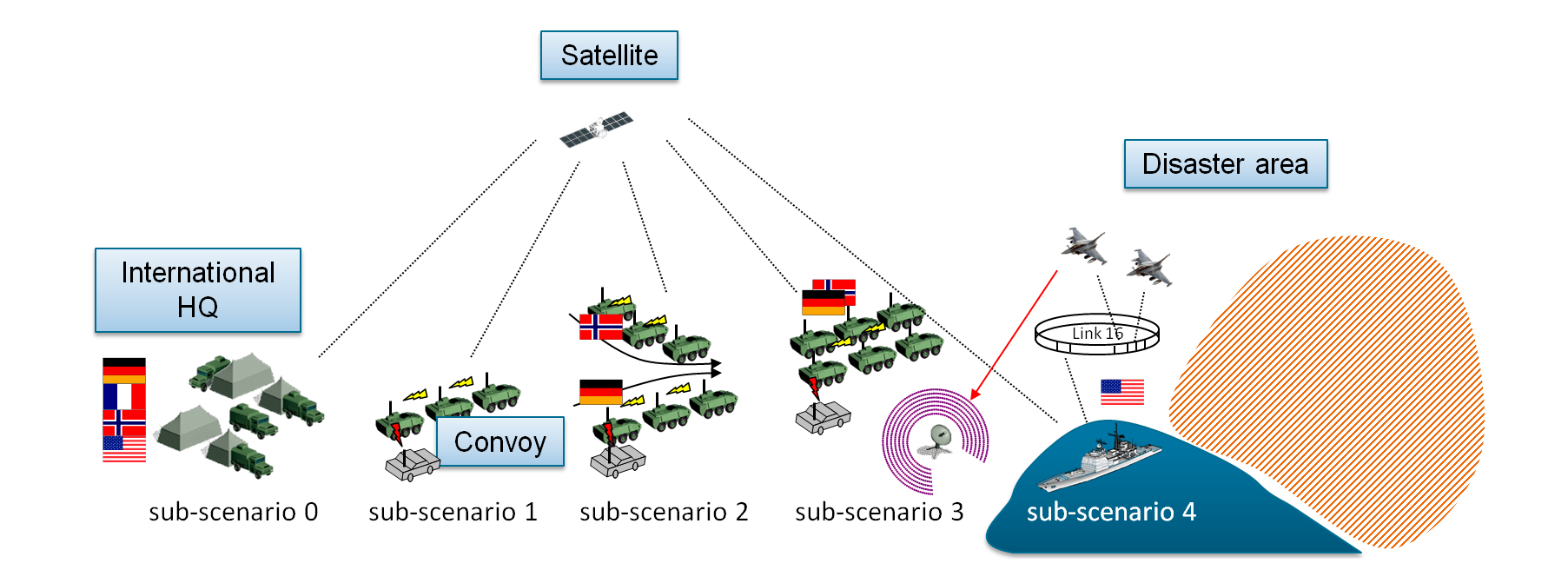The CoNSIS Scenario (Project Phase I)
The scenario takes place in a country torn by civil war. An international coalition is involved in this conflict to protect civilians and initiate the peace process. Main cities are controlled by coalition forces but countryside is not secured. Convoys and advanced posts are regularly attacked by armed groups. A Navy Task Force, consisting of surface vessels of coalition nations, is deployed in the waters of the Area of Operations. The vessels are deployed for a period of several months in order to patrol the area, control all the vessels that enter and exit the area, and execute search and rescue operations. The navy Task Force is establishing an ad hoc network. Vessels equipped with satellite links are providing high capacity reach-back capabilities to the rest of the Task Force. Traditional low throughput reach-back can be established via long range HF links.
Sub-scenario 0 – initial situation
A natural disaster occurs in an area not controlled by the coalition. This area is far away from the nearest coalition headquarters. Additionally, in the area there are civilian organizations (non-governmental organizations (NGOs), etc.) that already help the displaced population. There is a danger that enemy forces may take advantage of the situation to infiltrate the area.
Sub-scenario 1 – assembling aid convoys
The coalition headquarters decides to escort an NGO convoy to the disaster area. A battalion of coalition forces has been assigned to protect this convoy, to set up a security perimeter to protect the NGOs when building temporary camps to host the displaced population, and to facilitate the NGO activities providing coordination and security. The convoy consists of NGO vehicles and coalition armored cars. The convoy military vehicles are connected together in an ad hoc manner through a series of short hops. The convoy leaves the HQ.
Sub-scenario 2 – integration of new units in the convoy
Sometime after the convoy has left the HQ, it is joined by a second squad of military vehicles. This second squad is from a different nation and may use different radios internally. Communication between the convoys and between the convoys and the HQ is either done by satellite or by using radios compatible on the air. Some of the vehicles in the different convoys are equipped with these compatible radios, and the remaining vehicles communicate via the links set up by the compatible radios. These radios automatically discover each other.
Sub-scenario 3 – jamming attack
During the journey, the convoy radio communications are suddenly severely degraded due to jamming. The convoy informs the headquarters through the satellite link that is not affected by the jammer.
Sub-scenario 4 – reaction to the jammer
The UAV detects and localizes the communication jammer. It gathers various types of information about the jammer (e.g. snapshots, geographic location) and sends them to the Headquarters. The headquarters send a request for air support to the naval group using an available network link/path. Two aircrafts are launched from the carrier. Their mission is to destroy the jammer located by the UAV. The jammer is destroyed.
